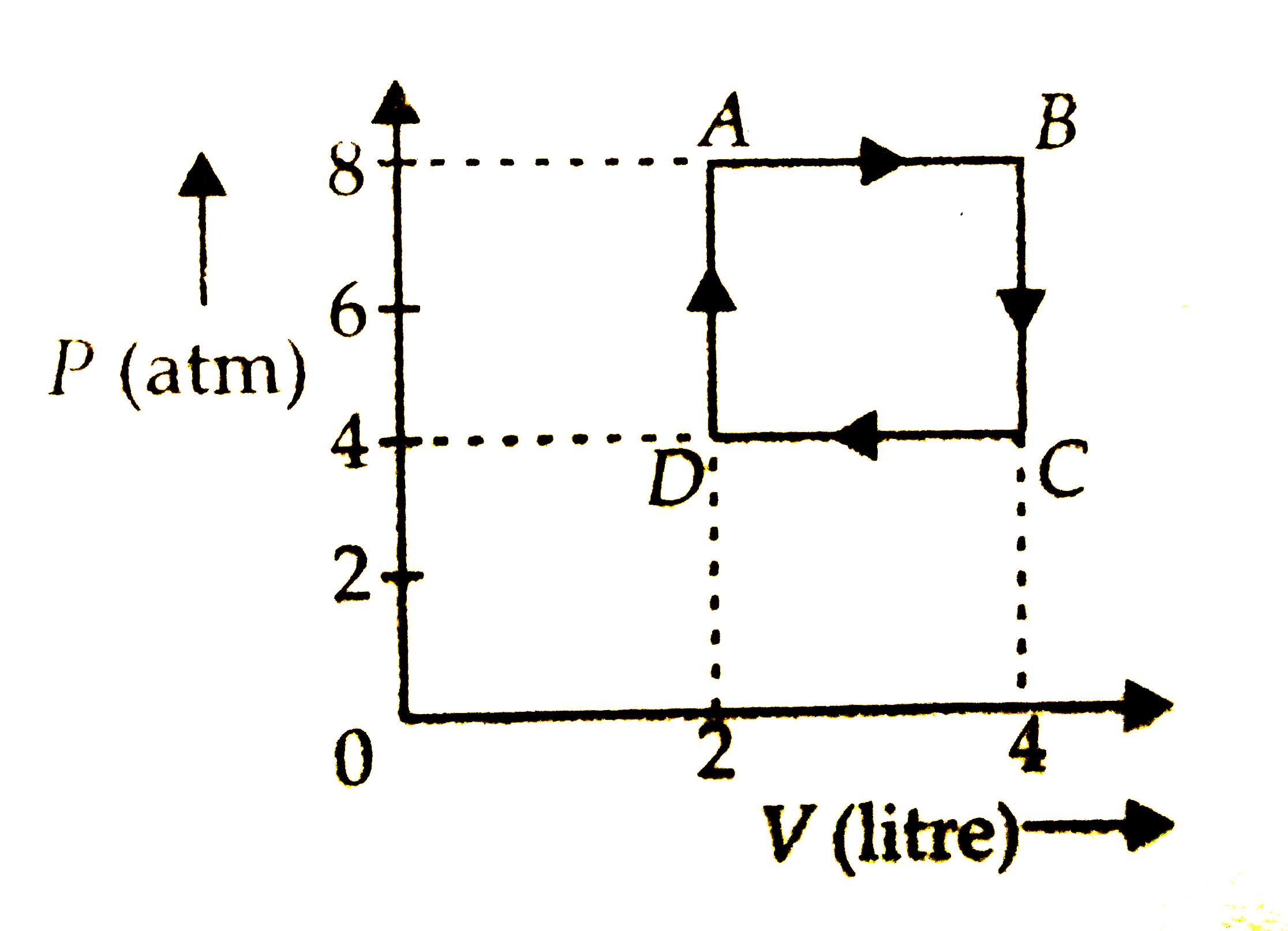A thermodynamical process is shown in the figure with pA=3×patm, VA=2×10−4m3, pB=8×patm, VC=5×10−4m3. In the process AB and BC, 600J and 200J heat are added to the system. Find the change in internal energy of the system in the process CA. [1patm=105N/m2]
![A thermodynamical process is shown in the figure with pA=3xxp(atm), VA=2xx10^-4m^3, pB=8xxp(atm), VC=5xx10^-4m^3. In the process AB and BC, 600J and 200J heat are added to the system. Find the change in internal energy of the system in the process CA. [1 p(atm)=10^5N//m^2]](https://d10lpgp6xz60nq.cloudfront.net/physics_images/DCP_V03_CH21_E01_094_Q01.png)
560 J
800 J
600 J
640 J
Since internal energy is a state function so the change in internal energy during the process AC will be same as that during the total process AB plue BC. Calculate the total wark ΔW during AB plus BC and total heat ΔQ during these processes. Then calculate ΔU=ΔQ−ΔW
During the processes AB the volume doesn.t change so work done is zero.
During BC the pressure is constant, so total work done
PB(VC−VB)=PB(VC−VA)∴VB=VA
=B×104[N/m2](5×10−3m3−2×10−3m3)=240J
∴ΔW during process AB plus BC = 240 J
Now given ΔQ during the same total process =600+200=800J.
∴ΔU=ΔQ−ΔQ=800−240=560J
Similar Questions
A thermodynamic process is shown in the following figure. The process and volumes corresponding to some points in the figure are:
PA=3×103Pa,
VA=2×10−3m−3,
PB=3×104Pa,VD=2×10−3m3
In process AB,600J of heat is added to the system and in the process BC,200J of heat is added to the system. the change in internla energy of the system in the process AC would be

View SolutionA thermodynamic process is shown in Fig. The pressures and volumes corresponding to some points in the figure are : PA=3×104Pa,PB=8×104Pa and VA=2×10−3m3,VD=5×10−3m.
In process AB,600J of heat is added to the system and in process BC,200J of heat is added to the system. The change in internal energy of the energy of the process AC would be.

View Solution
Knowledge Check
One mole of an ideal gas undergoes a cyclic process ABCDA as shown in the P-V diagram, The net work done in the process is
(1 atm=10^(6) dyne cm^(-2)) A500 JB700 JC800 JD900 J
A500 JB700 JC800 JD900 J
The P−V diagram of a system undergoing thermodynamic transformation is shown in figure. The work done by the system in going from A→B→C is 30J and 40J heat is given to the system. The change in internal energy between AandC is

View SolutionA gas expands against a constant pressure of 1 atm from a volume of 5L to 10L. During the process, system absorbs 400 J of heat from the surroundings. Calculate the change in the internal energy of the system.
View Solution500cm3 of a sample of an ideal gas is compressed by an average pressure of 0.1atm of 250cm3. During this process, 10J of heat flows out to the surroundings. Calculate the change in internal enegry of the system.
View Solution500cm3 of a sample of an ideal gas is compressed by an average pressure of 0.1atm of 250cm3. During this process, 10J of heat flows out to the surroundings. Calculate the change in internal enegry of the system.
View SolutionOne mole of an ideal gas undergoes change of state from (4 L, 3 atm) to (6 L, 5 atm). If the change in internal energy is 45 L-atm then the change of enthalpy for the process is
View SolutionThree processes compose a thermodynamic cycle shown in the accompanying P−V, diagram of an ideal gas.
Process 1→2 take place at constant temperature, during this process 60J of heat enters the system.
Process 2→3 takes place at constant volume. During this process 40J of heat leaves the system.
Process 3→1 is adiabatic.
What is the change in internal energy of the during process 3→1?
View SolutionAn ideal monoatomic gas initially in state 1 with pressure P1=20 atm and volume V11500cm3 it is then taken to state 2 with pressure P2=1.5P1 and volume V2=2V1 find the change in internal energy in this process in KJ. (take 1atm lit =100J)
View Solution
